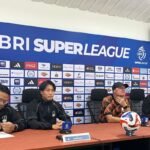Liga PANGKAL PINANG: An Overview of the Team Structure
1. History and Background
Liga PANGKAL PINANG, situated in the vibrant region of Indonesia’s Bangka Belitung Islands, has garnered attention over the years for its dedication to football development. The league operates as a vital platform to promote local talent, showcasing players who are passionate about the sport. Established with the intent to foster competitive spirit among local teams, Liga PANGKAL PINANG has become a cornerstone in the community, serving not only as entertainment but also as a means of promoting regional pride and unity.
2. Organizational Structure
The organizational structure of Liga PANGKAL PINANG is designed to streamline operations while ensuring that the competitive nature of the league is maintained.
-
League Management: The league is overseen by a governing body which consists of experienced individuals with a strong background in sports administration. This body handles everything from scheduling matches to managing partnerships and sponsorships.
-
Club Administration: Each participating club is run by its own administration, including a president, treasurer, and secretary. This small executive team is crucial as they manage the day-to-day activities of the club, align with league regulations, and maintain direct communication with the league organization.
3. Team Composition
The team structure within Liga PANGKAL PINANG is both diverse and dynamic. Each team typically comprises several key elements:
-
Players: A typical roster includes around 20 players, combining both experienced veterans and promising young talents. Clubs encourage a balanced mix to enhance team synergy and competitiveness.
-
Coaching Staff: Each team employs a head coach along with assistant coaches, fitness trainers, and goalkeeping coaches. The coaching staff is responsible for developing training regimens, educating players on tactics, and preparing the team for matches.
-
Support Personnel: Medical staff, including physiotherapists and doctors, play an essential role in maintaining player health. Equipment managers support logistical needs, ensuring that players have the right gear and supplies for practices and matches.
4. Youth Development Initiatives
To ensure sustainability and growth in talent pool, Liga PANGKAL PINANG places great emphasis on youth development initiatives.
-
Youth Academies: Many clubs maintain their own academies aimed at scouting and training young athletes. These facilities often serve as feeders to the senior teams, helping inexperienced players transition into professional settings.
-
Scouting Programs: Clubs conduct regular scouting events and combine tryouts where talented individuals can showcase their skills. This approach is complemented by collaborations with local schools and community outreach programs to increase football engagement.
5. Matchday Experience
The matchday experience is meticulously organized to foster a sense of community and excitement.
-
Venue Selection: Matches are held in various stadiums and fields throughout PANGKAL PINANG. Venues are chosen based on capacity, facilities, and location to maximize fan attendance.
-
Fan Engagement: Teams actively involve fans through events such as meet-and-greet sessions, fan club memberships, and social media interactions. Clubs often have dedicated fan bases that contribute to the electric atmosphere during matches.
-
Referee Assignments: Each match features certified referees trained to the league’s standards. The association ensures a professional level of officiating, enhancing the match quality and fairness.
6. League Format and Competition
The league operates on a seasonal format, aiming to maintain a high level of competition.
-
Regular Season: Teams compete in a round-robin format, where each team faces every other team. Points are awarded for wins and draws, establishing a league table that determines standings.
-
Playoffs: The top teams at the end of the regular season move on to a playoff stage to determine the league champion. This adds a layer of excitement as teams battle for the top honors.
-
Promotion and Relegation: While Liga PANGKAL PINANG is primarily a local league, there are opportunities for promotion to higher divisions, incentivizing teams to improve performance continuously.
7. Financial Aspects of Liga PANGKAL PINANG
Sustainability is a crucial aspect of Liga PANGKAL PINANG, and financial considerations play a significant role.
-
Sponsorship and Partnerships: Local businesses often partner with teams, providing vital financial support in exchange for brand visibility. These partnerships are essential for funding operations and enhancing club facilities.
-
Revenue Generation: Matchday revenues are bolstered by ticket sales, merchandise, and food concessions. Innovative strategies like online merchandise stores also expand revenue streams beyond traditional means.
8. Community Involvement
Verily, the connection between Liga PANGKAL PINANG and the local community cannot be understated.
-
Local Outreach: The league engages in various outreach programs, including workshops and charity events that utilize football as a tool for social change and development.
-
Cultural Events: Team events often coincide with local cultural festivals, tapping into the rich traditions of the region and bringing fans together through the shared love of football.
9. Media and Broadcasting
Media exposure is key to increasing the popularity of Liga PANGKAL PINANG.
-
Local Broadcasting: Games are often televised locally, with partnerships established with regional stations to maximize viewership. Some matches may also be live-streamed, tapping into digital platforms as audience engagement continues to shift online.
-
Social Media Presence: Each team actively engages fans through social media channels, offering behind-the-scenes content, match highlights, and player interviews, creating a dedicated following.
10. Future Perspectives
Liga PANGKAL PINANG is poised for growth and adaptability in the changing sports landscape.
-
Technological Innovations: Embracing technology in training, analysis, and fan engagement will be key. Investments in data analytics for player performance can elevate the competitive edge.
-
Sustainability Initiatives: Teams are exploring ways to make their operations more sustainable, from eco-friendly facilities to community programs promoting healthy lifestyles through sports.
By harnessing local talent and fostering community spirit, Liga PANGKAL PINANG continues to build itself as a pivotal institution within Indonesian football culture, paving the way for both present excitement and future development.




